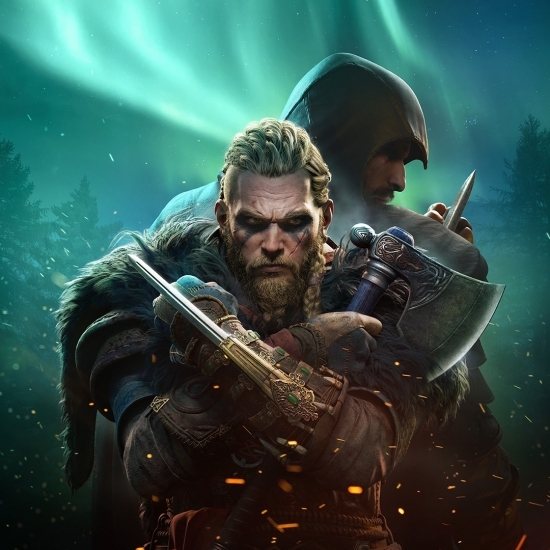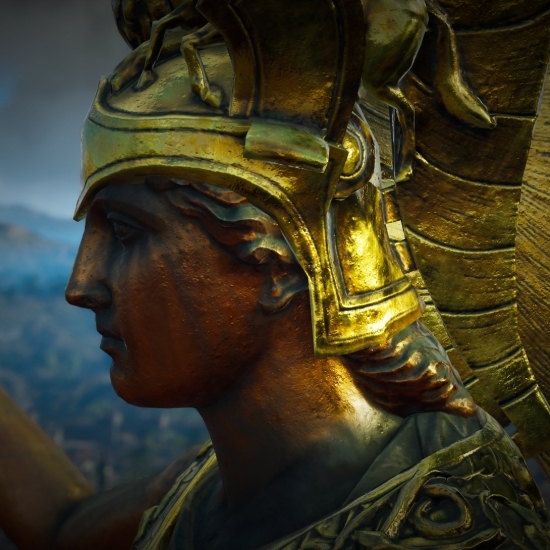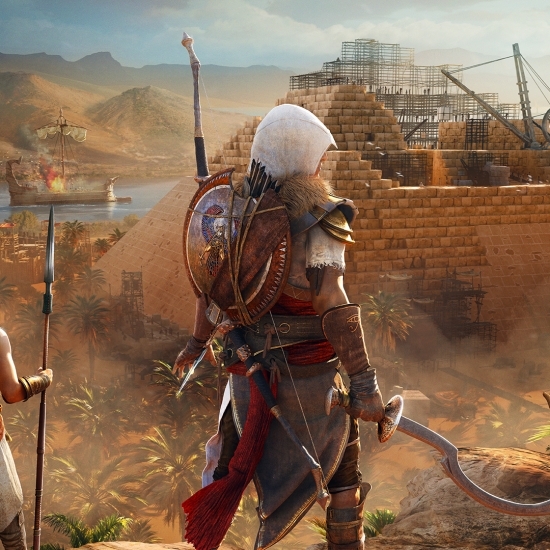INTRODUCTION
It’s been two years since we last relived our genetic memories in Victorian England with Assassin’s Creed: Syndicate, and the biggest gap between two Assassin’s Creed games since that between Altair and Ezio’s journeys (2007 – 2009). Now the wait is finally over and Assassin’s Creed Origins is here at last, taking us all the way back to antiquity, farther than any Assassin’s Creed game ever did before, as we relive the memories of Bayek of Siwa in 49 BCE in the final years of Ptolemaic Egypt.
Promised to tell an Origins story of the brotherhood during its formation years in the shape and form we know it by and a total revamp of the gameplay system and structure, while still preserving the essence and the continuity of the overarching narrative, the expectations of longtime fans and newcomers are at their peak for the upcoming main installment in the acclaimed franchise that sold over 100 million copies. Below I’ll discuss the various aspects of the game without spoiling the plot.
STORY
Assassin’s Creed Origins kicks off with a very emotional prologue, setting up the stage for a long, brutal and powerful journey focusing on the lives of Bayek, Aya and their alliances and enemies throughout Egypt. In a series of flashbacks, we learn of the motives that led Bayek and his wife, Aya to leave Siwa and start their journey by heading to Alexandria.
Their story, while based on its own dilemmas and goals, is also linked to the story of Cleopatra, Caesar and Ptolemy the last Pharaoh and the pivotal moments in their lives and therefore, the story isn’t grounded to mere months, but rather span across multiple years, which further helps in exploring the significant changes that took place in the later years of Ptolemaic Egypt’s history and also the development of our heroes and villains as characters.
Unlike pervious Assassin’s Creed games where side quests are merely a “get there > do that > finish” without much of a story value, Origins revamps that aspect with its quest-based system, making both main and side missions overflowing with little and big stories that gradually peel off the layers covering the core of our new protagonist, the people around him and exploring life for the people of Ptolemaic Egypt in their different social castes as well as diving deep into the mythologies, the beliefs, the gods and monsters of the era.
In a smart blend of beautifully-directed scenes, entertaining dialogues, scattered notes on papyrus hidden within temples and tombs or engravings on walls or overhead conversations of the people of Egypt, the story unfolds gradually informing players of the politics, the social values and issues, the beliefs and the overall atmosphere and lore.
Without spoiling much of the historical plot or the overarching narrative, Assassin’s Creed Origins is a much larger and a much more potent dose of storytelling than every game that followed Assassin’s Creed III, and part of the intelligent structuring is that it doesn’t alienate newcomers nor does it feel bare and stale for long-time fans.
CHARACTERS
In this chapter of Assassin’s Creed, characters are different from those in the previous ones, but also quite similar in other aspects. Bayek for example, is different from other Assassins who are mainly rebellious against their own belief systems or social standards, in fact, Bayek is a Medjay, which is a name for the police forces of that time (though the Medjays are rare in his time as their order is ending and he’s the last one left, or so) so he’s well-known and respected among his people, especially in Siwa, his hometown and he believes in their local religions and respects their gods and temples. People immediately recognize him as a Medjay based on his plate and attire or by knowing him personal or knowing about him and his heroism. While driven by grief and revenge, he’s quite charismatic, likable and intelligent and he’s well-informed of the world around him. He has an intelligent mixture of charisma and anger, determination to fulfill his quest and the desire and flexibility to help others, and it’s done so well that it doesn’t feel out-of-character. His relationship with Aya is among the most well-established relationships in an Assassin’s Creed game, and Aya herself is strong, determined, sharp and independent but also quite in love with Bayek and a very beautiful, likable and interesting as a character and quite convincing as an Assassin of her own time as well, and the chemistry between her and Bayek and the way they understand each other and support each other’s decisions and methods even when they sometimes differ, makes a beautiful sight to anticipate whenever they cross paths during the game.
Other characters, good and bad, are just as well-crafted even though not as thoroughly explored, yet the game makes sure that each of them delivers a great message, and without spoiling much, they enter and leave with a bang, adding another layer of mystery and elements to question aside from answering our lingering questions.
GAMEPLAY
The game lives up to its promise as a total revamp for the gameplay and structuring, totally eliminating the sequences system along with the optional objectives, completion percentages and collectibles, replacing those with a quest-based system which grants players total freedom to approach quests as they prefer, some quests only appear after finishing others or reaching specific areas, and others are on the map from the start and each quest can be approached in a stealthy manner or a one-man-army approach, of course different factors influence that decisions which I’ll touch upon ahead in this review.
The game also great encourages exploration more than ever, and this time through missions that take you all-over the world. All quests require players to search for them. The world is divided to various regions, each is fogged until you reach it, and they get unfogged as a whole without the need for viewpoints and by then, the map will start showing you question and exclamations marks. The question marks could be anything from tombs to temples to camps, settlements and predators’ lairs. As for exclamation marks, they refer to main and side quests which can only be activated from the game menu once you reach and interact with them, by then, you’re free to track the mission at any point from the game menu. In addition, markers for shops will appear within cities and settlements.
Assassin’s Creed Origins is a lot more exploration-driven than its predecessors and contrary to previous games, viewpoints only help expanding Senu’s perception which is another good upgrade that encourages players to explore the world and allowing players to effortlessly find new missions and activities as they traverse the vastness of Egypt, without the need for the chore-y and compulsory feel of having to synchronize a viewpoint, while still keeping that part just as fun due to the beauty of the structures which motivate players to climb and reach said viewpoint.
The game introduces a smart leveling system which greatly influences the way players approach quests, both main and side ones. Each time you highlight a quests on the map, it tells you the recommended level you’re required to reach to experience it. You can still play any mission at any time, but if you take a mission when you’re overly three levels below the recommended level, enemies will be lethal with as little as one or two melee or ranged attacks against Bayek. Like I mentioned before, you’re free to approach missions stealthily or in a one-man-army invasion, and that depends on your level, skill and gadgets. With a wide array of weapons and a plethora of exploratory and combat missions that help players level up before approaching missions of a higher level, and your choice of weapons also affects the damage you inflict on enemies, even those of a much higher level. I managed to conquered a camp and where enemies tower my level by 5 levels and still managed to beat it with a mix of stealth and ranged combat and distractions, so it’s not impossible to approach higher level missions, but it’ll be much more difficult as even air Assassinations which are now called “Leap Attack” won’t be lethal when you’re of a lower level than your target. Enemies also come in different classes, there are archers who are easier to kill as they seldom carry shields, there’s the higher class who are more melee combat oriented who are more difficult when approaching them face to face as their shields will deflect most of your attacks unless you use a shield-breaking attack, and then there are the big brutes who usually carry massive weapons like maces, and while many of them don’t carry shields (some carry massive ones) yet the damage they inflict per attack is much greater than others. Though one downside is that the same set of enemies is leveled differently and they do quite similar attacks which makes it feel a bit too “gamey” rather than a realistic evolution of enemy types from one area to another which justifies their difference in capability, strength and skill.
Quests, both primary and secondary are divided into multiple segments which Bayek is tasked to do consecutively, once one is finish, players can still choose to un-track it and follow another quest elsewhere and return to it later. Some quest tasks can only be performed at a specific part of the day, for example, finding at merchant in a market for a specific investigation might only be possible during the day in their working hours, while following a specific character to a certain destination is only possible after their working hours, which is later at night. Players can either choose to follow different quests until night falls or use the Dusk and Dawn feature to fast-forward to dusk or dawn and continue the same quest.
The ability to un-track and re-track can also be helpful when your level is lower than expected. If for example, you’re following a main quest and at some point, you encounter enemies that are too high for your level or the next quest within a main quest is of a much higher level than the Bayek’s, you can choose to leave, play some side quests to level up and then return when you’re ready.
The nature of quests vary from classic assassinations to assisting characters find certain items, reach certain points, save them from certain foes (and most of the time, there are multiple steps and sub-tasks that are required to be performed to finish said quest, as noted before) and sometimes quests aren’t given by others but merely activities that Bayek decides to do as he comes across, such as exploring the tunnels beneath the pyramids, finding ancient tablets, assisting rebels in their attacks, interacting with enigmatic stone circles where Bayek reflects upon his past and along the way uncover hidden secrets or finding papyrus papers within temples and unearthing valuable treasures within tombs, sunken temples, ships and caves. In addition, naval combat is back just as good as it was in Black Flag, though in a much more restricted and short span, but it’s a wonderful addition and makes for an enjoyable experience especially when the specific naval missions kick in unpredictably.
WORLD AND EXPLORATION
The world of Ptolemaic Egypt in Assassin’s Creed Origins is the most massive Assassin’s Creed world to date and the most rich, detailed and visually stunning one. From the lush and vibrant agricultural lands, to the massive cities overflowing with people who each have their own lives to follow throughout the different times of the day from shopping to working at shops, boats, ships and temples, to those praying for gods, to the rebels fighting off enemies which Bayek can assist if he comes across them at specific times and places to farmers working in the fields, the populations feels just as alive as the world is, but that’s not the only beauty about the world of Origins as the vast and empty desert, the dark mountain tops and valleys, naturally painted black by the nature of the rocks that cover their slopes and peaks and the sound of of the wind and the emptiness make for an incomparable meditative atmosphere and a natural call to explore every inch without the need for any chorey plotless activities and collectibles to force players to explore, but merely the beauty, the variety and the vastness is what drove me to investigate every corner of it.
The vastness of the world, the high-end visuals, the atmosphere and the population (or the lack, thereof in certain places) aren’t the only impressive parts about it, as the vastness and the variety in Origins mean unpredictability and elements of surprise. The massive deserts aren’t big for nothing, even when some parts are totally free of any side or main quests. In fact, you can finish the main game with a large portion of the map still un-fogged and untouched. However, this is one of the plus sides of the game, as by finishing the game, you basically have another game to play, a massive portion of strange lands to explore for the first time along with countless mesmerizing secrets buried underneath or hidden just behind that hill or a huge labyrinth of tunnels within that small opening in a mountain or a massive area to explore within a Tomb that you could easily miss after finding the treasures inside the temple, which adds layers of story to the already well-established plot of the game. In short, you could never really know what you’ll find in a specific location.
VISUAL FIDELITY
When presenting a world as vast and as rich and detailed as the world of Assassin’s Creed Origins, graphics are quite an important aspect that serves much more than a cosmetic feature and Origins does not disappoint. In fact, Origins is probably the best looking Assassin’s Creed to date, it looks much better than it does in any promotional video released so far. It is a huge factor in giving life to this massive world. From the realistic-looking water both when it’s still or startled by wildlife, people or Bayek’s boat or swimming motion, to the abundance of beautifully designed flamingos that inhabit the lush areas and the half submerged temples, to the detailed and variant rocks that cover the world in abundance to the beautiful candle lights and lanterns that turn temples like those in Memphis into a spot to behold like a real-world luxury spa, Origins excels in presenting a living work of art to behold and the highly demanded Photo Mode feature further encourages players to explore and take photos all around the breathing world of Egypt.
SOUND AND AMBIANCE
Sarah Schachner excels in giving more life to the world’s first simulator of Ptolemaic Egypt with her score and soundtrack that she composed for Origins. Ambient music is back and in a very intelligent way. The score plays a great role in setting the tone for each region and each moment of the game, with sounds that are a mixture of the ancient and the modern. Some of the themes are grand and epic while others are calm and atmospheric, some borrow elements from the Assassin’s Creed Movie themes, giving it a darker and more “new” tone, while others convey the grandeur of specific moments of emotions, life-changing decisions or sorrow and joy in others. It’s a great blend and it’s implemented in an intelligent way that the ambient music don’t play everywhere nor every time, it’s programmed in a way that it feels surprising, natural and true to the the moment and for me that is a very smart move as the game world is structured in a very artistic and realistic way that it’s meant to give different feels and reflect the variety and the uniqueness of each region.
While traversing big cities, hearing the chatter with the noises of workers and the sounds of birds, water and a tint of true-to-the-era sound plays, on the other hand, you hit the long road to travel from one area to another, you’re left to listen to the steps of your horse and camel or the action you come across and suddenly along the way, music plays giving the scene a different tone. When exploring vast and barren regions like the enigmatic mountains of the Black Desert, the sound of the wind is a perfect way to convey the emotion of actually being there, without hearing another sound but that of nature itself, and as the player switches to Senu for a bird’s eye view, you are surprised by the honest-to-the-era music that plays as Senu hovers above the dark lands at night. For me, this is an ideal way of scoring Origins as music can sometimes feel repetitive and or annoying especially when you wanna enjoy the realism of each scene. Assassin’s Creed Origins presents quite a memorable score in comparison to those of its predecessors since Black Flag, ACIII and Revelations.
FINAL WORD
With the advent of Assassin’s Creed Origins, a new era of the franchise is beginning, a total revamp for gameplay and an honest return to form and a huge improvement upon its predecessors in terms of story-telling, art direction, world building, cinematic directing, theatrical representation of key moments, in addition to the revamped gameplay and the intelligent implementation of story elements in both main and side quests and activities, in addition to the beauty of the world, the choice of setting and era and the visual fidelity and the vastness of the atmosphere makes any player feel quite motivated to explore and carry out as many quests as possible and makes leaving the game quite hard. For someone who always resented side quests due to their blandness and pointlessness, I felt quite motivated to play as many of them as I could in one session because every bit of them is enjoyable, whether it’s exploring an ancient temple or crossing a desert during a storm and encountering mirage apparitions here and there, diving underwater for treasure or exploring famous monument which we’re yet to visit in real life.
The over-arching narrative is brought to light in Origins a lot more than its predecessors and is divided in both main and optional quests, and the game gives a great deal of indirect help to remind and to inform long-time players and newcomers, respectively of what happened in the past installments regardless of their various formats, in Origins and it helps taking steps in bridging the gap between different mediums of storytelling within the Assassin’s Creed Brand.
The new protagonists help a great deal in influencing our emotions in different ways, from joyful moments and humorous ones to dark, serious and sad ones in a way that previous protagonist were far less successful in doing so, and for the first time since Ezio and Connor that I truly feel that I care about the historical story and the characters, in addition to the various nods to iconic elements and moments that we know from previous titles and a plethora of surprises towards the end for players to enjoy. I can confidently say that the final moments made my heart skip a beat at least three times. It must be noted and to avoid spoiling the plot, I wish the story spent more time exploring certain elements from past games and to give a bit more substance to specific parts and sometimes certain moments showcased in some trailers and early demos were missing or gave the impression then, that they’d play a bigger role, but ultimately did not, yet I believe and hope that the coming expansions will touch upon, yet neither of those stripped made the story feel lacking. On the contrary, it’s the most interesting and rich Assassin’s Creed experience since Ezio Auditore’s trilogy and the best Assassin’s Creed installment after Desmond Miles.
Assassin’s Creed Origins doesn’t only tell another story nor provide closure, it’s a beginning before anything else and not only in terms of the birth of the brotherhood, but it feels like a start of a whole new arc that I beg the developers to use Origins as their template to build the next title accordingly and expand from there on.
Story 9.5/10
Characters 10/10
Gameplay 10/10
World & Exploration 11/10
Visual Fidelity 9.5/10
Sound and Ambiance 9.5/10
Total 9.8/10
Assassin’s Creed Origins launches digitally and physically October 27th, 2017 on PS4, Xbox One and PC.
-
 RINO THE BOUNCERPharmacist. Visual Artist. Ubisoft Star Player, Assassin's Creed Brand Ambassador, Founder and Community Leader of The Codex. Tomb Raider Localization Ambassador and Official Fansite Founder.NEWS FEEDTestimonial"Just stumbled across this site after looking at some topics on the Ubisoft Forums, this is great! Exactly the thing I was looking for.""Your site lays everything down in an interesting and easy to read format, even I learn new things whilst reading your articles!""This needs more than just 5 stars!""There is only one word AMAZING!!!!!!! GREAT WORK.""Very in depth and very well thought out! Keep up the good work!"One of the best (if not the best one) AC community pages out there. Keep up the good work!
RINO THE BOUNCERPharmacist. Visual Artist. Ubisoft Star Player, Assassin's Creed Brand Ambassador, Founder and Community Leader of The Codex. Tomb Raider Localization Ambassador and Official Fansite Founder.NEWS FEEDTestimonial"Just stumbled across this site after looking at some topics on the Ubisoft Forums, this is great! Exactly the thing I was looking for.""Your site lays everything down in an interesting and easy to read format, even I learn new things whilst reading your articles!""This needs more than just 5 stars!""There is only one word AMAZING!!!!!!! GREAT WORK.""Very in depth and very well thought out! Keep up the good work!"One of the best (if not the best one) AC community pages out there. Keep up the good work!






